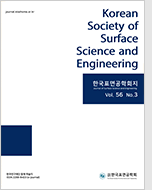
- Past Issues
- e-Submission
-

2021 Impact Factor 1.766
5-Year Impact Factor 1.674
Editorial Office
- +82-2-563-0935
- +82-2-558-2230
- submission@kssse.or.kr
- https://www.kssse.or.kr/

2021 Impact Factor 1.766
5-Year Impact Factor 1.674
The Korean Society of Surface Science and Engineering 2023;56(1):69-76. Published online: Feb, 28, 2023
DOI : 10.5695/JSSE.2023.56.1.69
The effects of hairline treatment on surface blackening and thermal diffusion behaviors of Zn-Al-Mg alloy coated steel sheet were evaluated by the three-dimensional surface profiler and laser-flash technique. The metallographic observation of coating damages by hairline treatments showed that several cracks were initiated and propagated along the interface between primary Zn/eutectic phases. As the hairline processing became more severe, the crack occurrence frequency in eutectic phase of coating layer and the surface roughness increased, which had a proportional relationship with the level of blackening on the coating surface. In addition, the higher interfacial areas of the blackened coating surface, caused by the hairline process, led to an increase in thermal diffusivity and conductivity of the coated steel sheet. On the other hand, when the coating damage by hairline treatment was excessive and the steel substrate was exposed, there was little difference between the thermal diffusivity/conductivity of the untreated sample though the blackening degree was higher than that of untreated sample. This work suggests that the increase in the surface areas of the coating layer without exposure to steel substrate through hairline treatment can be one of the effective technical strategies for the development of Zn-Al-Mg alloy coated steel sheets with higher blackening level and thermal diffusivity.
Keywords hairline; roughness; blackening; thermal diffusivity; conductivity.